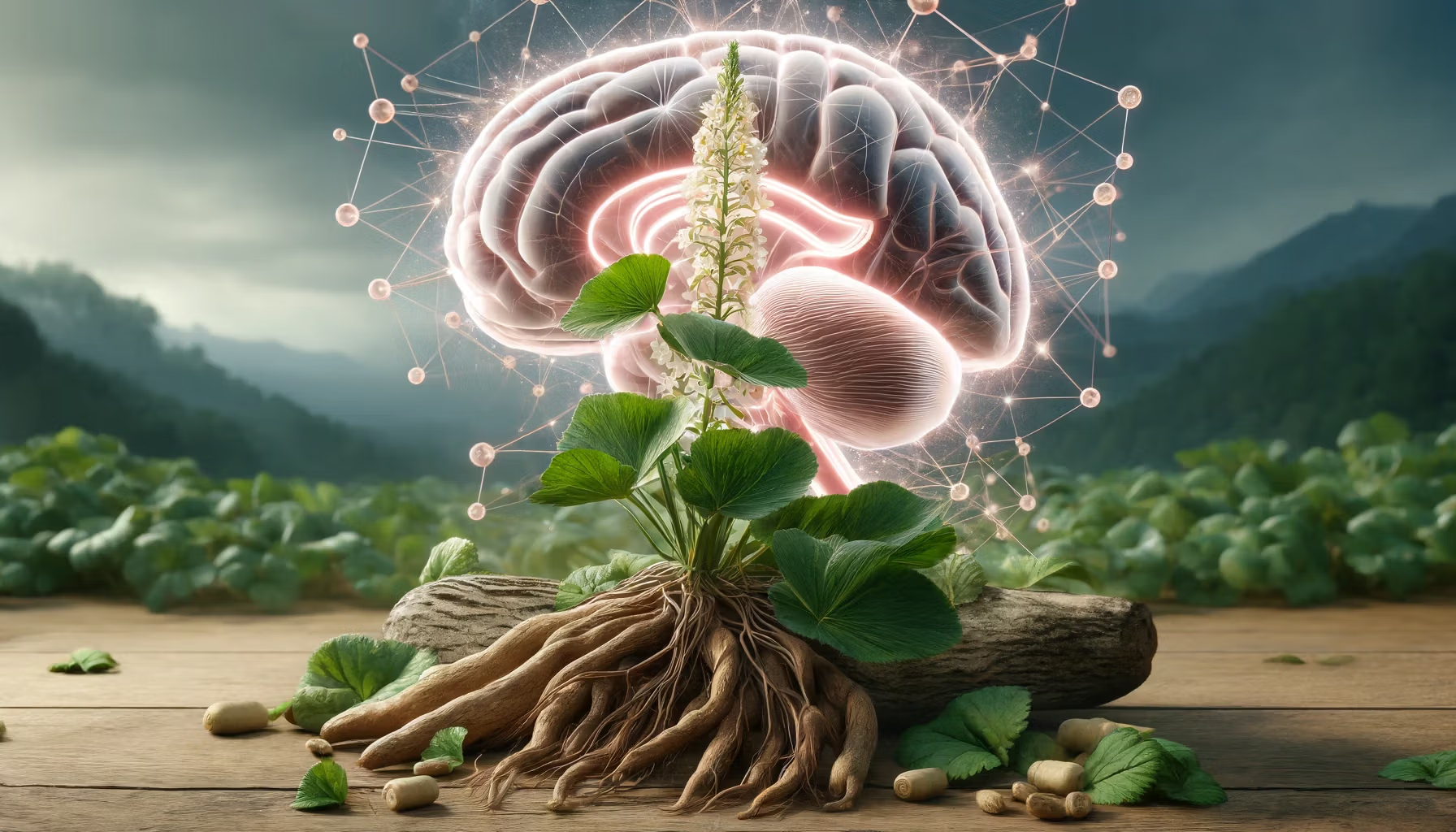
Licorice (Glycyrrhiza glabra) is more than just a flavorful treat.
It’s a potent nootropic that can enhance cognitive function, reduce stress and anxiety, improve mood, and provide neuroprotection.
This article shares everything you need to know about this plant’s unique cognitive benefits, as well as it’s optimal dosages, potential side effects and risks.
Table of Contents
What is Licorice?
Licorice (also known as alcacuz, gan cao, gan zao, and sweet root) is a perennial herb native to the Mediterranean region, central to southern Russia, and Asia Minor to Iran. It’s part of the legume family (Fabaceae).

The licorice plant can grow up to 1 meter tall and has pinnate leaves and purple to pale whitish blue flowers.
The root of the licorice plant contains glycyrrhizin, a compound 30-50 times sweeter than sugar, which gives licorice its characteristic sweet taste.
The roots are harvested after 2-3 years, then dried and processed into various forms including powders, teas, tinctures, and candies.
Licorice is typically used as a flavoring agent in candies, beverages, and tobacco products.
Licorice has a long history of use in traditional medicine systems like Ayurveda and Traditional Chinese Medicine.
Some traditional uses of licorice include:
- Soothing sore throats and coughs
- Reducing inflammation
- Supporting digestion
- Treating stomach ulcers
- Relieving adrenal fatigue
More recently, research has revealed licorice’s potential as a nootropic, thanks to its ability to enhance cognitive function and protect the brain.
What Are The Bioactive Compounds in Licorice?
The main bioactive compounds in licorice include:
- Glycyrrhizin: A triterpenoid saponin that gives licorice its sweet taste and is responsible for many of its therapeutic effects.
- Flavonoids: Licorice contains several flavonoids, such as liquiritin, isoliquiritin, and glabridin, which have antioxidant and anti-inflammatory properties.
- Coumarins: Compounds like glycycoumarin and licopyranocoumarin are present in licorice and may contribute to its potential health benefits.
How Bioavailible is Licorice?
Overall, Licorice has high bioavailability when consumed orally.
One of its bioactive compounds, glycyrrhizin, has an oral bioavailability of around 22%.
The bioavailability of other compounds, such as glabridin, has been reported to be as high as 60%.
This means that a significant portion of the compound is absorbed into the bloodstream and can reach the brain to exert its nootropic effects.
What are the Mechanisms of Action for Licorice?
Licorice exerts its nootropic effects through several mechanisms of action:
- Modulation of neurotransmitters: Licorice compounds, such as glycyrrhizin and glabridin, have been shown to influence neurotransmitter levels, including serotonin, dopamine, and GABA.
- Anti-inflammatory and antioxidant effects: The flavonoids and other compounds in licorice possess anti-inflammatory and antioxidant properties, which may help protect brain cells from damage and promote optimal cognitive function.
- Neuroprotection: Licorice compounds have demonstrated neuroprotective effects in various studies, potentially helping to prevent age-related cognitive decline and neurodegenerative diseases.
What Are The Cognitive Benefits of Licorice?
Licorice has been associated with several cognitive benefits, including:
- Improved memory
- Reduced stress and anxiety
- Enhanced mood
- Neuroprotection

How Does Licorice Improve Memory and Learning?
Licorice improves memory and learning by increasing the activity of acetylcholine, a neurotransmitter critical for cognitive function.
A study by Dr. Dhingra found that licorice extracts enhanced memory and learning in mice by inhibiting acetylcholinesterase, the enzyme that breaks down acetylcholine. (1)
By maintaining higher levels of acetylcholine in the brain, licorice supports better memory and learning.
How Does Licorice Reduce Stress and Anxiety?
Licorice reduces stress and anxiety by modulating the activity of the hypothalamic-pituitary-adrenal (HPA) axis, the body’s stress response system.
Glycyrrhizin, a key compound in licorice, has been shown to reduce cortisol levels and promote a calming effect.
A clinical study found that glycyrrhizin inhibited 11β-hydroxysteroid dehydrogenase, an enzyme that activates cortisol, leading to lower stress levels.(2)
How Does Licorice Enhance Mood?
Licorice enhances mood by increasing the levels of dopamine and serotonin, neurotransmitters associated with pleasure, reward, and emotional well-being.
A clinical study demonstrated that glabridin, a flavonoid found in licorice, inhibited the reuptake of dopamine and serotonin, leading to higher levels of mood-boosting neurotransmitters in the brain.(3)
How Does Licorice Provide Neuroprotection?
Licorice provides neuroprotection through its antioxidant and anti-inflammatory properties.
The flavonoids in licorice, such as glabridin and isoliquiritigenin, scavenge harmful free radicals and reduce oxidative stress in the brain.
A clinical study found that licorice extracts protected neurons from damage caused by amyloid-beta, a protein linked to Alzheimer’s disease, by reducing inflammation and oxidative stress in mice.(4)
What Are The Potential Side Effects and Risks of Licorice?
While licorice is generally considered safe when consumed in moderate amounts, it can cause side effects with high dosages or prolonged use, such as:
- Hypertension: Licorice can cause an increase in blood pressure due to its effects on the mineralocorticoid receptor.
- Hypokalemia: Excessive licorice consumption can lead to low potassium levels, which may cause muscle weakness, fatigue, and irregular heartbeat.
- Hormonal imbalances: Licorice can interfere with the body’s steroid metabolism, potentially leading to hormonal imbalances.
- Digestive issues: Some people may experience digestive discomfort, such as bloating or diarrhea when consuming licorice.
Note: Most adverse effects have been seen with doses of 100 mg glycyrrhizin or more per day.
Who Should Avoid Licorice?
Certain individuals should avoid or limit their licorice intake, including:
- People with hypertension: Due to its potential to increase blood pressure, licorice should be avoided by those with pre-existing hypertension.
- Pregnant and breastfeeding women: There is limited research on the safety of licorice during pregnancy and breastfeeding, so it’s best to avoid it during these periods.
- Individuals with hormone-sensitive conditions: Licorice may interfere with hormone levels, so people with conditions like breast cancer, uterine fibroids, or endometriosis should avoid this natural nootropic and find an alternative.
What Are The Potential Interactions Between Medication and Licorice?
Licorice can interact with several medications, including:
- Diuretics: Licorice may enhance the potassium-depleting effects of diuretics, leading to hypokalemia.
- Blood pressure medications: Licorice can interfere with the effectiveness of blood pressure medications and may cause an increase in blood pressure.
- Corticosteroids: Licorice may potentiate the effects of corticosteroids, increasing the risk of side effects.
- Oral contraceptives: Licorice may interact with oral contraceptives, potentially affecting hormone levels.
It’s crucial to consult a healthcare professional before using licorice supplements if you are taking any medications to avoid potential interactions.
How To Use Licorice as A Nootropic?
Licorice can be consumed in various forms as a nootropic, including:
| Form | Characteristics |
|---|---|
| Licorice root extract | Standardized licorice extracts are available in capsule or tablet form, making it easy to control the dosage. |
| Licorice tea | Steep 1-2 teaspoons of dried licorice root in hot water for 5-10 minutes to make a brain-boosting tea. |
| Black licorice candy | While black licorice candy contains some of the active compounds, it’s not the most reliable way to consume licorice for nootropic purposes due to the added sugar and variable licorice content. |

What Are The Different Types of Licorice?
The two main types of licorice used as supplements are standard licorice root and deglycyrrhizinated licorice (DGL).
Standard licorice root contains the full spectrum of active compounds, including 2-24% glycyrrhizin. It’s available in teas, tinctures, capsules and tablets.
Due to the glycyrrhizin content, it’s not recommended for long-term use or for those with high blood pressure.
DGL is a processed form of licorice with the glycyrrhizin removed. This makes it safer for long-term use.
DGL still retains the beneficial flavonoids and is often used for digestive issues like ulcers and heartburn. It’s commonly found in chewable tablets and capsules.
What Are The Pros and Cons of Licorice?
Consider the following before choosing to use Licorice for brain power augmentation:
| Pros | Cons |
|---|---|
| Potential anti-inflammatory effects | Glycyrrhizin can cause adverse effects |
| May benefit digestive health | Interacts with many medications |
| Possible antiviral properties | Not safe for everyone |
| Potential skin benefits | Overconsumption can be dangerous |
What is The Recommended Dosage for Licorice?
The recommended dosage for licorice depends on the form and concentration of the product. Generally, the following dosages are considered safe and effective:
| Form | Dosage |
|---|---|
| Licorice root extract (standardized to contain 20% glycyrrhizin) | 150-300 mg per day |
| Dried licorice root | 1-5 grams per day, brewed as a tea |
| Deglycyrrhizinated licorice (DGL) | 380-1140 mg per day, for those sensitive to glycyrrhizin |
Note: Many licorice candies and supplements in the U.S. do not contain significant amounts of glycyrrhizin, as they are often made with anise oil instead of actual licorice root.
What Do Users of Licorice Say?
Users of licorice as a nootropic report various cognitive benefits, including:
- “Licorice helps me stay focused and productive throughout the day.” – John D., software developer
- “I find that licorice tea helps me feel calmer and more relaxed, without making me drowsy.” – Sarah L., yoga instructor
- “Since I started taking licorice extract, I’ve noticed an improvement in my memory and ability to learn new things.” – Mark R., college student
Can Licorice Be Used in A Nootropic Stack?
Yes, licorice can be used in a nootropic stack to potentially enhance its cognitive benefits. Some common nootropics that may pair well with licorice include:
- Bacopa monnieri: This herb has been shown to improve memory and cognitive function, and its effects may synergize with licorice.
- Rhodiola rosea: Known for its adaptogenic properties, Rhodiola may help reduce stress and fatigue, complementing the potential stress-reducing effects of licorice.
- Ginkgo biloba: This herb is known for its potential to improve memory and cognitive function, and its antioxidant properties may synergize with those of licorice.
When creating a nootropic stack, it’s essential to start with low doses and carefully monitor your response to each component before combining them.
- Dhingra, Dinesh et al. “Memory enhancing activity of Glycyrrhiza glabra in mice.” Journal of ethnopharmacology vol. 91,2-3 (2004): 361-5. doi:10.1016/j.jep.2004.01.016↩
- Kim, Beom Jun et al. “Increased Expression of 11β-Hydroxysteroid Dehydrogenase Type 1 Contributes to Epidermal Permeability Barrier Dysfunction in Aged Skin.” International journal of molecular sciences vol. 22,11 5750. 27 May. 2021, doi:10.3390/ijms22115750↩
- Ofir, Rivka et al. “Inhibition of serotonin re-uptake by licorice constituents.” Journal of molecular neuroscience : MN vol. 20,2 (2003): 135-40. doi:10.1385/JMN:20:2:135↩
- Cho, Min Ji et al. “Comparison of the effect of three licorice varieties on cognitive improvement via an amelioration of neuroinflammation in lipopolysaccharide-induced mice.” Nutrition research and practice vol. 12,3 (2018): 191-198. doi:10.4162/nrp.2018.12.3.191↩

